#Glady Antrobus
Explore tagged Tumblr posts
Text
Thornton Wilder - The Skin of Our Teeth at Very Little Theatre
A mellow summer continues to provide peaceful space for pondering past and future travel adventures. With the havoc and devastation of deadly wildfires, floods, and wars currently happening in the world, it feels good to be hidden away in leafy Oregon. I’m slowly working my way through a “to do” list, and diligently trying to tame the woodsy landscape that surrounds my home. Letting things go…

View On WordPress
#1943 Pulitzer Prize for Drama#Anthony C. Edwards#Antrobus Family#Ashley Ecker#Burlesque#Dave Shaw#Denise LaCroix#George and Maggie Antrobus#German Expressionism#Glady Antrobus#Henry Antrobus#James Joyce Finnegans Wake#Japanese attack on Pearl Harbor#Leslie Murray#The Skin of Our Teeth#Thornton Wilder#Thornton Wilder American Playwright#Thornton Wilder One-Act Plays#Vaudeville#Very Little Theatre (VLT) Eugene Theatre
0 notes
Text
One of my core memories of high school theatre is the time when the kid playing Henry Antrobus used our break to bang out the intro to “STARSTRUKK” by 3oh!3 on the set of lockers in the hallway, and we were all super impressed ‘cause it sounded exactly like the song. Now he’s a chef for the restaurant inside Benaroya Hall and ten years sober, and we haven’t spoken since high school although I did see him walking downtown once and we made eye contact and I yelled hi but he didn’t hear me. To this day I can’t hear the song without thinking of that moment and I love how life gives us these little visceral moments like that.
#yes I played Gladys Antrobus#high school theatre#3oh!3#the skin of our teeth#millennial#90s kid#early 2000s#2010s#2010s nostalgia#after that show closed I heard a rumor that he’d asked a mutual friend about me because he had a crush#he asked the friend where does she party I want to run into her#and the friend was like she doesn’t#and he was like what#and they said she doesn’t party#like she just doesn’t#😂#me in high school#my fave 30h!3 song is DONTTRUSTME tho
4 notes
·
View notes
Text






The Skin of Our Teeth - ITV - March 15, 1959
A presentation of "ITV Play of the Week" Series 4 episode 29
Comedy / Drama
Running Time: 90 minutes
Stars:
Vivien Leigh as Sabina
George Devine as Mr. Antrobus
Margaret Rawlings as Fortune Teller
Ruth Dunning as Mrs. Antrobus
David McCallum as Henry Antrobus
Perlita Neilson as Gladys Antrobu
Jimmy Thompson as Floor Manager
William Dexter as Doctor / Fred Bailey / Master of Ceremonies
Marta Downs as Mrs. E. Muse
Fiona Duncan as Mammoth / Technician
Daphne Newton as Mrs. T. Muse
Henry Oscar as Homer / Mr. Treymayne
Bernard Rebel as Judge Moses
Ian Whittaker as Telegraph Boy
This was Vivien Leigh's only television appearance.
#The Skin of Our Teeth#TV#ITV#Comedy#Drama#1959#1950's#ITV Play of the Week#Vivien Leigh#George Devine#Margaret Rawlings#Rugh Dunning#David McCallum#Perlita Neilson#Jimmy Thompson
2 notes
·
View notes
Text
THE SKIN OF OUR TEETH
1942
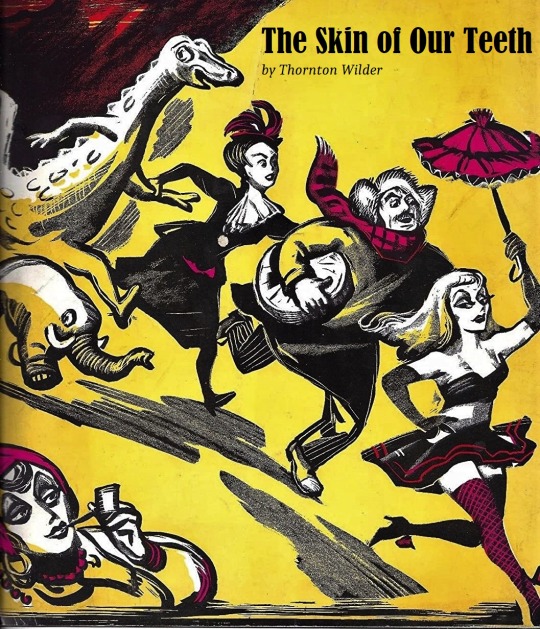
“The Skin of Our Teeth” by Thornton Wilder was written in early 1942 and premiered on Broadway in November of that year, after tryouts in Philadelphia, Washington DC, and New Haven. It opened at Broadway’s Plymouth Theatre on November 18, 1942. By 1942, Atlantic City was no longer one of the regular cities to host out-of-town tryouts. Baltimore and Washington were also on the try-out schedule, but were dropped when rehearsals were delayed due to cast commitments.
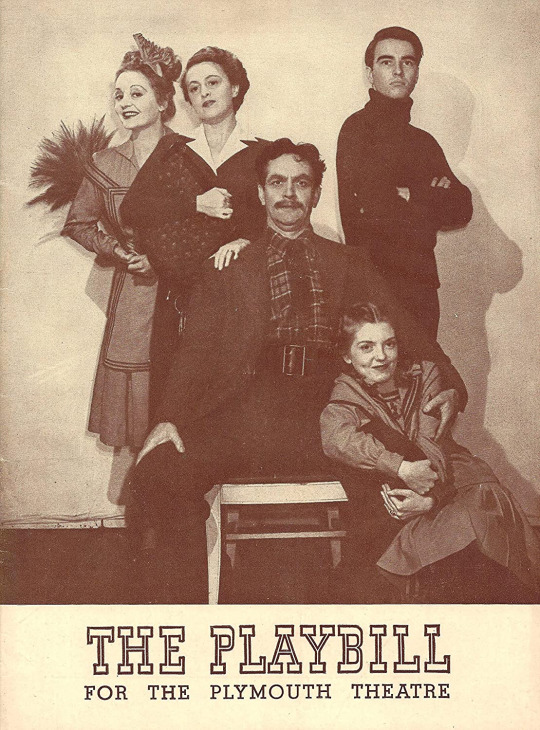
It was produced by Michael Myerberg and directed by Elia Kazan with costumes by Mary Percy Schenck. The play is a three-part allegory about the life of mankind, centering on the Antrobus family.
The original production starred Tallulah Bankhead (as Sabina the Maid), Fredric March (George Antrobus), Florence Eldridge (Mrs. Antrobus), and Montgomery Clift (as son George). Bankhead won a Variety Award for Best Actress and the New York Drama Critics Award for Best Actress of the Year for her role as Sabina. When she left the production in March 1943, she was replaced by Miriam Hopkins. The play won the Pulitzer Prize for Drama.
The phrase used as the title comes from the King James Bible, Job 19:20: "My bone cleaveth to my skin and to my flesh, and I am escaped with the skin of my teeth."
There were Broadway revivals in 1955 and 1975 with another revival planned for 2022 at Lincoln Center. There was a production at the Central Park Delacourte Theatre in 1998.

Although the play was never filmed as a motion picture, a San Diego production aired on PBS TV in 1983.

There were also television productions in 1951 and 1955 (above with Helen Hayes and Mary Martin), 1959 (UK), and 1961 (Germany).
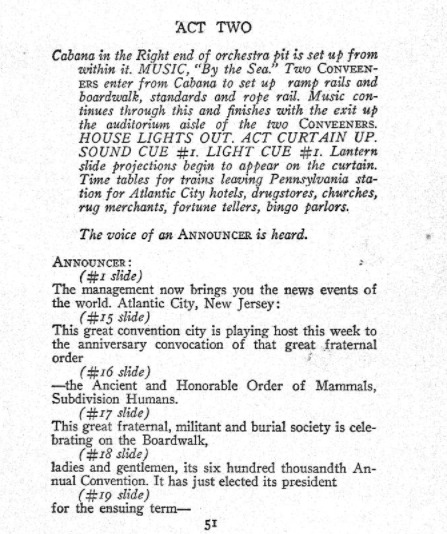
The play’s second act is set on the Boardwalk in Atlantic City. Acts One and Three are set in the fictional New Jersey town of Excelsior. The author, although not born in New Jersey, had ties to the state. He attended Princeton University, and taught school in Lawrenceville NJ. His now-iconic play “Our Town” had its first performances at McCarter Theatre in Princeton.
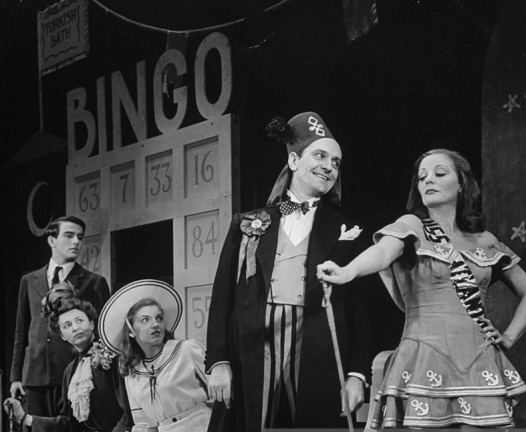
In 1931, Wilder wrote a one-act titled “The Happy Journey to Trenton and Camden.” Almost the entire play takes place during an automobile journey from Newark to Camden, New Jersey by a family on their way to visit a married daughter, who has recently lost a baby in childbirth.
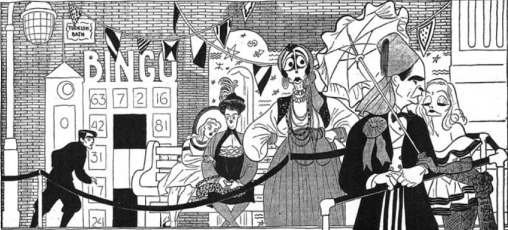
In Atlantic City, the Antrobuses are present for father George's swearing-in as president of the Ancient and Honorable Order of Mammals, Subdivision Humans. Sabina the maid is present, also, in the guise of a scheming beauty queen, who tries to steal George's affection from his wife and family. Children Gladys and George each attempt their individual rebellions, and are brought back into line by the family. The act ends with the family members reconciled and, paralleling the Biblical story of Noah's Ark, directing pairs of animals to safety on a large boat where they survive the storm and/or the end of the world.

The real Atlantic City in 1942.
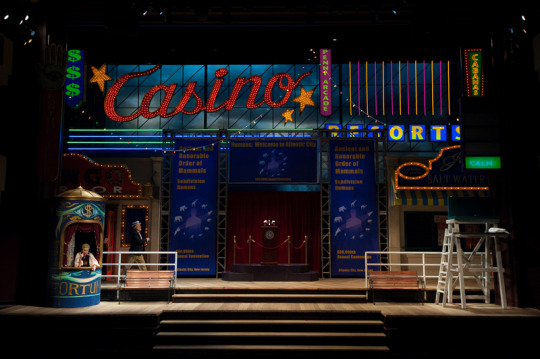
The play capitalizes on Atlantic City’s reputation as a popular spot for conventions, beauty pageants, fortune tellers, and gambling (in the form of Bingo) - all things the city is still known for today. Many productions include Atlantic City’s famous rolling chairs in their design.

Although the original production was set in the present (1942) some modern productions also set the show in the present day, meaning set designers are free to use more modern Atlantic City iconography.
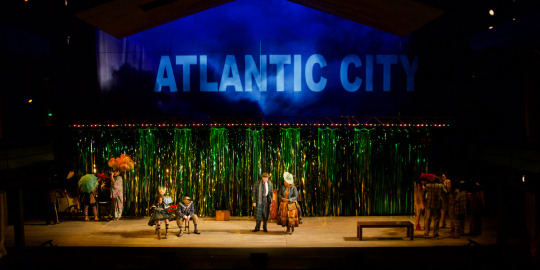
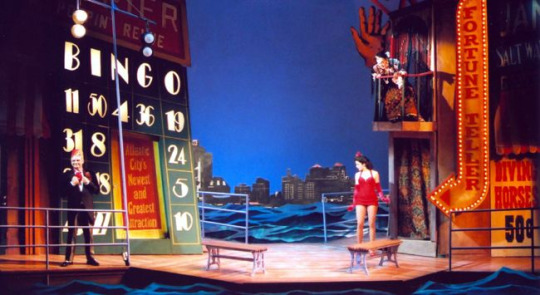
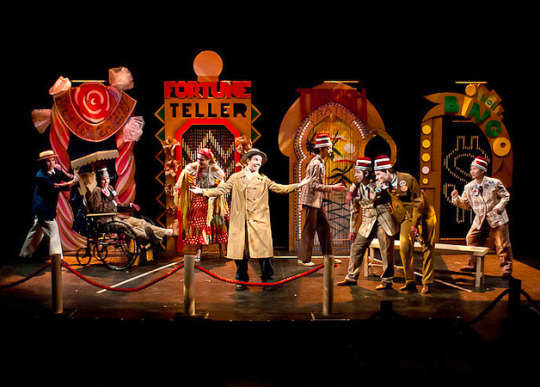
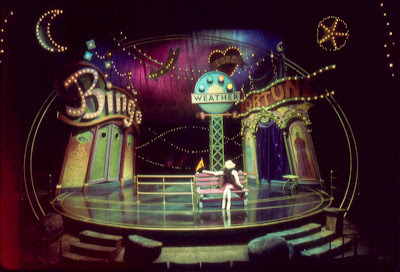
#Atlantic City#Thornton Wilder#The Skin of Our Teeth#Broadway#Boardwalk#Theatre#1942#New Jersey#NJ#Stage
4 notes
·
View notes
Photo

The Skin of Our Teeth (revival) by Thornton Wilder, directed by Alan Schneider. Special engagement at the ANTA Theater, Aug. 17–Sept. 3, 1955. Announcer Earl George Sabina Mary Martin Mr. Fitzpatrick Paul Morrison Mrs. Antrobus Helen Hayes Dinosaur Vinie Burrows Mammoth Patricia Taffe Telegraph Boy Fred Kareman Gladys Heller Halliday Henry Don Murray Mr. Antrobus George Abbott Doctor Frank Hamilton Professor Jonathan Anderson Judge Frank Silvera Homer Howard Fischer Miss E. Muse Eileen Lear Miss T. Muse Frances Sternhagen Miss M. Muse Maude Sheerer Fortune Teller Florence Reed Chair Pusher Frank Silvera Broadcast Official Earl George Ass’t Broadcast Official Frank Hamilton Fred Bailey Howard Fischer Hester Maud Sheerer Ivy Vinie Burrows Mr. Tremaine Frank Silvera
Conveners, Tourists, Atlantic City Sightseers: Emily Cobb, Jack Delmonte, John Dorman, David Elliott, Tom Geroghty, Lily Lodge, Richard O’Neill, Ann Stanwell

On this day, August 17, in 1955, a star-studded production of The Skin of Our Teeth opened on Broadway at the ANTA Theater. It had originally been staged in Paris by the American National Theatre and Academy as part of the “Salute to France” celebration. It was later presented in several American cities with largely the same cast, and a shortened version was telecast as part of NBC’s “Producers Showcase” in 1955.

Above: Mary Martin (standing) and, seated, George Abbott, Helen Hayes, Heller Halliday (Martin’s daughter), and Don Murray.
#Skin of Our Teeth#Thornton Wilder#Mary Martin#George Abbott#Helen Hayes#Don Murray#Frances Sternhagen#Florence Reed
26 notes
·
View notes
Text
by Macey Levin
Through history humanity has escaped extinction numerous times but total destruction is still a distinct possibility. There was, of course, the flood that Noah and his ark overcame after forty-something days. The Black Plague. The atomic bombs that closed World War Two, and today who knows what will happen with a narcissistic finger on the red button that would send devastation throughout the world. This eternal possibility is key to Thornton Wilder’s The Skin of Our Teeth receiving a problematic production at Berkshire Theatre Group‘s Fitzpatrick Main Stage in Stockbridge, MA.
Wilder won three Pulitzer Prizes for the novel The Bridge of San Luis Rey and the plays Our Town and The Skin of Our Teeth. His works explore the connection between mankind’s everyday experiences and its place in the universe. His characters. whether from Peru, Grovers Corners, New Hampshire, or Excelsior, New Jersey, are ordinary people living simple lives.
In The Skin of Our Teeth we meet George (Danny Johnson,) who has just invented the wheel, and Maggie (Harriet Harris) Antrobus (from the Greek word for “human”,) their children Henry (whose name used to be Cain – Marcus Gladney, Jr.,) Gladys (Claire Saunders,) and Sabina (a la the rape of the Sabine women) the maid. There are myriad Biblical, historical and mythological references throughout the play. Though set in 1942, the year it was written, there are many anachronisms. The first act has Excelsior’s citizens waiting for an oncoming ice age as mountains of ice are covering the land. The Antrobus’s pet dinosaur and mammoth come into the house to stay warm; weary and frightened travelers, including Homer, Moses, three Muses and others are invited into the house. In the second act, a monster rainstorm is about to occur. There are contemporary references to Berkshire Medical Center and Outside Mullingar which is running at the Unicorn Theatre. A present-day thematic note is that the Antrobuses are racially mixed.
A conceit that occurs several times has actors breaking out of character mid-scene and addressing the audience. In the first act Sabina, (Ariana Venturi) playing the actress Miss Somerset, tells us she doesn’t understand the play, hates it and maybe we should leave. Act two is on the Atlantic City boardwalk where the populace awaits the impending storm. A fortune teller addresses the audience. In the third act Mr. Antrobus informs the audience that a few of the actors haven’t arrived and some of the designers, a janitor and the head usher will take over those parts, but first the stage manager will run a rehearsal. The company hopes the audience will forgive them and be patient.
The subject matter, the end of civilization, is very dark but the first two acts could be played lighter; the darkness of the production is the director’s (David Auburn) choice. In these acts there are whimsical moments that effectively contrast with the dire circumstances. Act three, other than the break for “rehearsal,” is heavier; it takes place after a seven-year war when Maggie and Gladys, who has a baby, have been living in a bunker under the house while Henry and George are fighting in the war. Sabina, who has been a camp-follower, re-joins them. Father and son argue as to whether the human race can ever stop annihilating itself and do they deserve to survive?
This slideshow requires JavaScript.
Johnson and Harris have control of their respective roles as the Antrobuses. They skillfully mine the humor and sentimental moments while giving depth to the more powerful scenes as does Gladney Jr.’s Henry, especially in the last act when he challenges his father’s optimistic desire to rebuild civilization. Saunders’ transition from a somewhat ditzy teen-ager to a world-weary mother is touching. Sabina is the most animated character and Venturi throws out her laugh lines with aplomb. There are times, however, when her projection could be stronger.
Auburn’s direction keeps the play moving as he touches Wilder’s thematic intentions. As mentioned above, however, the tones of the three acts could be more effectively accomplished to enhance these issues. Act two’s Atlantic City boardwalk uses many actors in addition to the principals. Some of the staging, along with the set and props, appears haphazard when it should be controlled chaos. Otherwise, Bill Clarke’s sets for the first and third acts – the Antrobus home before and after the war – accommodate the staging and the surrounding environment. Daniel J. Kotlowitz’s lighting, like the sets, is too dark except when it functions dramatically for the third act. The costumes by Hunter Kaczorowski identify the characters’ stations as well as reflecting their personalities.
The Skin of Our Teeth is not an easy play to produce. BTG should be congratulated for daring to mount this seventy-seven-year-old play that speaks to our troubled times.
The Skin of Our Teeth by Thornton Wilder; Director: David Auburn; Cast: Lauren Baez (Muse, Conveneer, Chair Pusher, Usher Bailey) Lynnette R. Freeman (Homer, Fortune Teller, Ivy) Marcus Gladney Jr. (Henry) Harriet Harris (Mrs. Antrobus) Danny Johnson (Mr. Antrobus) Ralph Petillo (Moses, Bingo Caller, Mr. Tremayne) Claire Saunders (Gladys) Marjie Shrimpton (Muse, Telegraph Boy, Hester) Matt Sullivan (Stage Manager, Broadcast Official) Ariana Venturi (Sabina) Kennedy Haygood, Isabel Jordan, Hanna Koczela, Alex O’Shea, Tony Reimonenq, Julian Tushabe (Acting Interns); Scenic Designer: Bill Clarke; Costume Designer: Hunter Kazorowski; Lighting Designer: Daniel J. Kotlowitz; Resident Composer, Sound Designer: Scott Killian; Wig, Hair and Makeup Designer: J. Jared Janas; Movement Director: Isadora Wolfe; Stage Manager: Abigail Gandy; Running time: two hours, forty five minutes, two intermissions; 7/11/19 – 8/3/19; Berkshire Theatre Group, Fitzpatrick Main Stage, Stockbridge, MA , www.BerkshireTheatreGroup.org; 413-997-4444
REVIEW: “The Skin of Our Teeth” at the Berkshire Theatre Group by Macey Levin Through history humanity has escaped extinction numerous times but total destruction is still a distinct possibility.
#Abigail Gandy#Alex O’Shea#Ariana Venturi#Berkshire Theatre Group#Bill Clarke#BTG#Claire Saunders#Daniel J. Kotlowitz#Danny Johnson#David Auburn#Fitzpatrick Main Stage#Hanna Koczela#Harriet Harris#Hunter Kazorowski#Isabel Jordan#Isadora Wolfe#J. Jared Janas#Julian Tushabe#Kennedy Haygood#Lauren Baez#Lynnette R. Freeman#Marcus Gladney Jr.#Marjie Shrimpton#Matt Sullivan#Ralph Petillo#Scott Killian#Stockbridge MA#The Skin of Our Teeth#Thornton Wilder#Tony Reimonenq
0 notes